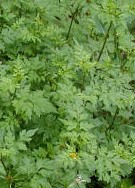 Spanish needles is a summer annual native to tropical America. It is found along most of the East coast, Midwest, South and west to California. Spanish needles prefers partial shade, moist to medium conditions, and loamy fertile soil but tolerates less. It grows well in disturbed sites and can be found in pastures, abandoned fields, open woodlands, riverbanks, as well as waste areas such as vacant lots and roadsides.
Spanish needles is a summer annual native to tropical America. It is found along most of the East coast, Midwest, South and west to California. Spanish needles prefers partial shade, moist to medium conditions, and loamy fertile soil but tolerates less. It grows well in disturbed sites and can be found in pastures, abandoned fields, open woodlands, riverbanks, as well as waste areas such as vacant lots and roadsides.
 Description: Seedlings appear in early summer in soil that was cultivated or disturbed in spring with stems below the cotyledons showing a shade of maroon.
Description: Seedlings appear in early summer in soil that was cultivated or disturbed in spring with stems below the cotyledons showing a shade of maroon.  The true leaves are opposite, borne on 2” petioles and are up to 8 inches long and 4 inches wide. They are double or triple pinnately compound and resemble fern fronds. The erect stems are green or reddish green, square in cross-section and grow 2-5 feet tall. The upper stems branch and terminate in single yellow flowerheads about ¼ inch across from mid-summer into fall. Each flowerhead consists of disc flowers surrounded by 0-5 petal-like ray flowers, although the petal-like structure may be missing. The flowers quickly shrivel and become elongated seed heads bearing numerous dark brown seeds with 2-4 barbs that can cling to the fur of animals or clothing of humans, and facilitate seed dispersal. The root system is a fibrous taproot.
The true leaves are opposite, borne on 2” petioles and are up to 8 inches long and 4 inches wide. They are double or triple pinnately compound and resemble fern fronds. The erect stems are green or reddish green, square in cross-section and grow 2-5 feet tall. The upper stems branch and terminate in single yellow flowerheads about ¼ inch across from mid-summer into fall. Each flowerhead consists of disc flowers surrounded by 0-5 petal-like ray flowers, although the petal-like structure may be missing. The flowers quickly shrivel and become elongated seed heads bearing numerous dark brown seeds with 2-4 barbs that can cling to the fur of animals or clothing of humans, and facilitate seed dispersal. The root system is a fibrous taproot.

 Control: Young plants are easy to pull up when the soil is moist. To reduce seed production in older plants cut or mow them periodically throughout the bloom period. Individual mature plants can be treated with glyphosate and severe infestations can be treated with herbicides such as dicambra and 2,4-D.
Control: Young plants are easy to pull up when the soil is moist. To reduce seed production in older plants cut or mow them periodically throughout the bloom period. Individual mature plants can be treated with glyphosate and severe infestations can be treated with herbicides such as dicambra and 2,4-D.